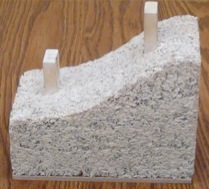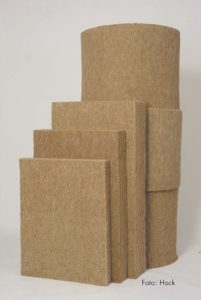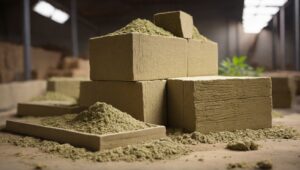Hempcrete’s Unique Promise and Properties.
Did you know that construction accounts for nearly 40 percent of global energy consumption? Forty percent! That’s massive. It also means construction offers an equally massive opportunity to make a difference in terms of sustainability.
A fascinating application of industrial hemp is its versatility as a building material. Known for its extremely long fibers and woody stalk, the hemp plant provides base materials that can be converted into numerous building products.

As the name implies, hemp can be used as substitute to concrete. Yet, hempcrete does not (yet) function as an exact 1:1 alternative so perhaps it should be best viewed as a complementary material which enhances structures and eliminates unneeded materials. While hempcrete does not perform every function of traditional concrete, it does offers properties concrete does not.
How Hempcrete is made
Hempcrete is made using the wood-like core of the industrial hemp, called the hurd, mixed with a lime-based binding material. This core is high in silica content making it able to bind very well with lime, a rare quality among plant-based material. This results in a lightweight cementitious material weighing 1/8th of concrete and capable of floating in water!

The use of the hemp stalk is desirable because many other parts of the hemp plant, like seeds, are grown for use in so many other applications that the stalk is forgotten and discarded as a waste product. This means that as hemp production increases for other uses (e.g., USDA certified organic hemp oil, food, etc.), the availability of hemp stalks increases while costs decrease.
How Hempcrete is used
Currently, hempcrete is carving out a niche as a building material, particular with respect to walls. Hempcrete technology has not reached the point where it is as strong as traditional concrete, but it can be used to infill or otherwise coat the walls of structures ranging from commercial buildings to residential homes. Essentially, hempcrete is typically either formed into blocks then used to build, or, more commonly, blown into or otherwise placed into forms where it dries in place.
How Hempcrete is valuable
Here’s where the fun begins. Hempcrete offers extremely unique and valuable properties builders are beginning to recognize.
Fireproof
The National Fire Protection Association reported that between 2014-2018, on average, 353,100 home structure fires occurred per year. This resulted in 2,620 deaths, 11,030 injuries, and $7.2billion in direct property damage per year. The emotional harm is likely not calculable. Guess what doesn’t burn? Hempcrete. And we mean really doesn’t burn. One group submitted hempcrete for ASTM E84 testing—what regulatory bodies in the U.S. rely on to declare whether a material is fireproof. Hempcrete scored a 0 on the Flame spread Index, a scale from 0 to 450. Scoring a 0 is hempcrete’s way of saying, “I aced this.”
Insulation qualities

One European researcher concluded an in-depth study as follows: “When taking into account the whole package, hempcrete can provide high thermal inertia, no thermal bridges and the overall thermal transmittance with the recommended thickness. It cannot be denied that it has a great potential as a thermal insulation material.” Hempcrete’s extremely favorable insulation qualities are dramatically enhanced by another feature of hempcrete, discussed next.
Breathability
Hempcrete is known to be a “breathable” material insofar is it absorbs and releases water vapour well. This breathability is another way of saying hemp has a favorable vapor permeability. This results in hempcrete’s fantastic property of stabilizing temperature inside a building. This occurs through the effects of evaporation and condensation within pores of the hempcrete material thus taking advantage of latent heat effects. Remember, sweat cools you off because the water evaporates. This principle applied to hempcrete provides the upshot of increased comfort and efficiency.
Water Proof
Hempcrete is (or at least can be made) water proof and rot resistant. This obviously presents significant value because many natural fibers fail in the face of water exposure. Given that hempcrete incorporates lime, its pH is high causing antimicrobial and antifungal properties.
Waste Control/CO2 Sequestration
If hempcrete is used for walls, drywall and fiberglass insulation is dramatically reduced. The waste and material elimination does not end there—hempcrete actually eliminates a substantial amount of CO2, making it an extremely “green” product. Not only does the industrial hemp plant absorb carbon dioxide during its quick growth cycle, but the actual hempcrete product itself absorbs CO2, some estimate between 307.26kg to 470.3kg per m3 of lime hemp concrete can be absorbed and locked up, making its carbon footprint tiny.
Sound Proof
Hate to hear the AC kick on in the middle of the night? Or that teenager peeling out while trying to impress friends? Hempcrete is noted for its ability to act as a barrier to noise pollution. As one research paper concluded: “Buildings and rooms built using hemp concrete enable exposure of high sound absorbing surfaces, and hence low reverberation times, with a reduced need for additional acoustic treatment.
Structural advantages
A 2×4 or 2×6 wall with insulation and drywall is weaker than a wall infilled with hempcrete. As mentioned, hempcrete alone is not used as a pure structural material—though this can change as hempcrete brick are perfected. However, infilling walls with hempcrete can significantly strengthen the existing structural elements. Hempcrete is 3 times more elastic than concrete, making it a fantastic material in the face of earthquakes. The earthquake produces micro-cracks in the wall which then bind themselves when moisture contacts free lime. One study determined that “it was found that high density hempcrete (715 kg/m3) not only prevents weak-axis buckling of columns but also carries some direct load. Low density hempcrete was also successful in preventing weak-axis buckling of the infilled walls.”
CONCLUSION
Hempcrete solves problems and provides unique advantages as building material. It makes our world more sustainable and just, frankly, better. Imagine a future where you reside within your foot-thick hempcrete walls. The big bad wolf is outside huffing and puffing but unable to blow your house down. Thankfully, you remain serene inside, unable to even hear his futile attempts. Instead, you break into a small smile as you notice how perfect the temperature always seems to be inside your wonderful hemp home while still being incredibly sustainable. You go to bed peacefully, untroubled by any thought your home might catch fire or crumble in the face of an earthquake. When you wake, you realize none of it was a dream, but simply a future made present by industrial hemp.
RESOURCES
Fireproof
Home Structure Fires report | NFPA
In US, Hempcrete Isn’t Fireproof… (hempitecture.com)
Insulation
A review of the properties of hemp concrete for green building applications – ScienceDirect
U Value vs. R Value – ~ (stanekwindows.com)
Vapor permeability
(PDF) Study of a hempcrete wall exposed to outdoor climate: Effects of the coating (researchgate.net)
Water https://www.researchgate.net/publication/312173948_Study_of_a_hempcrete_wall_exposed_to_outdoor_climate_Effects_of_the_coating
Carbon sequestration
(PDF) Assessment of Carbon Sequestration of Hemp Concrete (researchgate.net)
Sound
(PDF) Acoustic absorption of hemp-lime construction (researchgate.net)
Structural
Structural benefits of hempcrete infill in timber stud walls | Request PDF (researchgate.net)
Video on Hempcrete from Hemp.com







